What is PropTech Industry & How it Reshapes the Real Estate Market
- December 06
- 15 min

Data analytics reshapes how we manage, invest, and operate in commercial real estate. By merging property technology with powerful tools like artificial intelligence and cloud-based property management systems, the industry is making smarter, faster decisions that were once impossible. These advancements in real estate technology are setting the stage for a more efficient and forward-thinking approach.
For property managers and stakeholders, relying on data-driven insights is no longer just an option—it’s becoming a key to staying competitive. Data allows us to predict trends, track performance, and make informed choices, whether it’s about enhancing tenant experiences, optimizing resources, or reducing environmental impact. From adopting emerging technologies in real estate to utilizing commercial real estate artificial intelligence, these innovations are fundamentally changing the landscape.
This article dives into the benefits of data analytics in PropTech, exploring how it’s being used to tackle real-world challenges and enhance operations. Whether it’s cutting costs, improving sustainability, or managing complex portfolios, you’ll discover how data shapes commercial real estate’s future.
The world of commercial real estate has been transforming, with technology guiding the way forward. Predictive analytics is a game-changer among the many advancements reshaping the industry. By leveraging PropTech platforms, predictive models can analyze data patterns to forecast property trends, offering actionable insights that empower property managers and stakeholders. From anticipating tenant turnover to optimizing lease renewals, predictive analytics redefines how commercial real estate is managed. This approach relies on historical data to anticipate future demands, providing an edge in a competitive and fast-evolving market.
Predictive analytics uses algorithms and machine learning to identify data patterns, trends, and anomalies. PropTech platforms, which integrate data from various sources like IoT devices, property management software, and financial records, are the foundation for these predictive models. By analyzing this data, real estate professionals can gauge shifts in tenant behaviors, market cycles, and property demands.
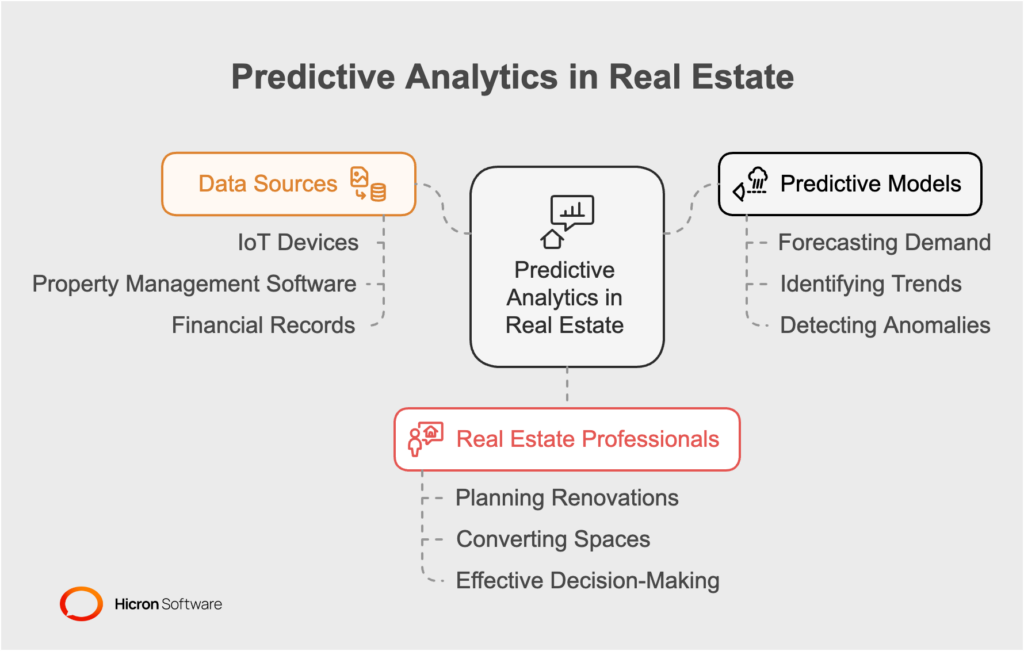
For example, a commercial real estate firm can use predictive models to forecast demand for office spaces based on economic indicators, such as employment trends and industry growth. If job growth in a city aligns with a rise in start-ups, predictive analytics can alert property managers to plan renovations or expansions to cater to this demand. Similarly, these models can identify underutilized spaces and suggest converting them into coworking areas, aligning property usage with incoming patterns.
This capability allows commercial properties to stay ahead of the curve by recognizing opportunities and challenges before they fully materialize, driving more effective planning and decision-making.
Tenant retention is one of the most crucial aspects of commercial property management, and predictive analytics is making this process more precise. Tenant turnover can often be anticipated by analyzing several factors, such as payment history, lease agreements, complaints, and maintenance requests. For instance, an increase in unresolved maintenance issues or consistent delays in rent payments can signal tenant dissatisfaction. Predictive analytics doesn’t just highlight a potential problem—it enables property managers to uncover patterns and root causes.
Imagine a PropTech platform showing a particular tenant who filed multiple service requests over the last quarter and received delayed responses. Based on this data, predictive models might assign a risk score, alerting property managers that this tenant is more likely to vacate. Proactively addressing the tenant’s concerns—by resolving issues faster or providing additional support—could significantly increase the chances of renewal.
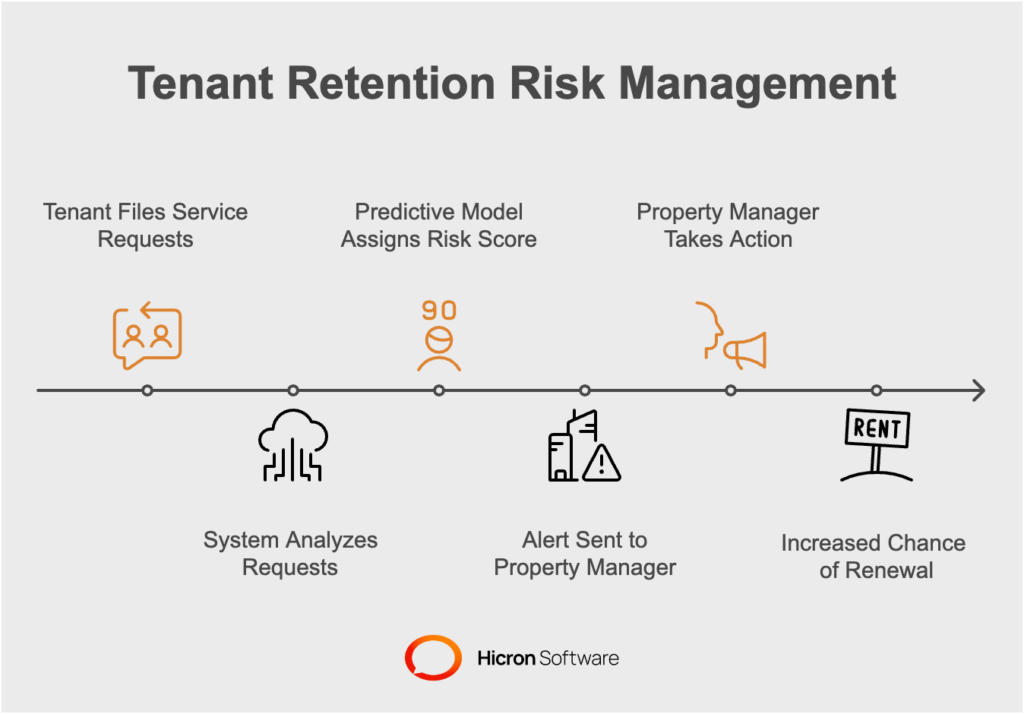
This level of anticipation benefits property managers and stakeholders alike, reducing costly vacancies and building long-term relationships with tenants.
Lease renewals are another area where predictive analytics provides significant advantages. Instead of waiting for lease expiration dates to start discussions, predictive models can analyze factors that influence renewals, such as market rates, the financial health of tenants, and occupancy rates in competing properties.
For example, a retail property manager is concerned with retaining a high-value tenant. Predictive analytics can evaluate their revenue trends, foot traffic at the property, and comparative market data to suggest optimal rates for renewal. If the analytics show that the broader market is experiencing rent surges, the manager can lock in the tenant at a competitive rate before they consider relocating to a lower-cost alternative. On the other hand, if the model indicates that foot traffic to the tenant’s store is declining, it could be a signal to negotiate terms that keep the tenant satisfied.
Maximizing the timing and terms of lease renewal negotiations can benefit both property owners and tenants, fostering a trusting and sustainable business relationship.
Behind every predictive model lies a treasure trove of historical data. Historical data is the backbone of any predictive analytics system, allowing algorithms to recognize recurring patterns, correlations, and anomalies. For commercial real estate, this data can include rental trends, vacancy reports, market demographics, and even seasonal shifts in demand.
For instance, a property manager overseeing office spaces may use historical data to observe that smaller units are consistently in higher demand during the fourth quarter of each year. Equipped with this knowledge, they can prepare for higher leasing activity by running targeted marketing campaigns in advance or offering promotions for early commitments.
Similarly, historical market data can help developers prioritize construction projects based on demand forecasts. Suppose data indicates a steady rise in demand for mixed-use spaces in urban settings. Predictive analytics can then recommend specific land plots or guide the design of properties to align with those growing trends.
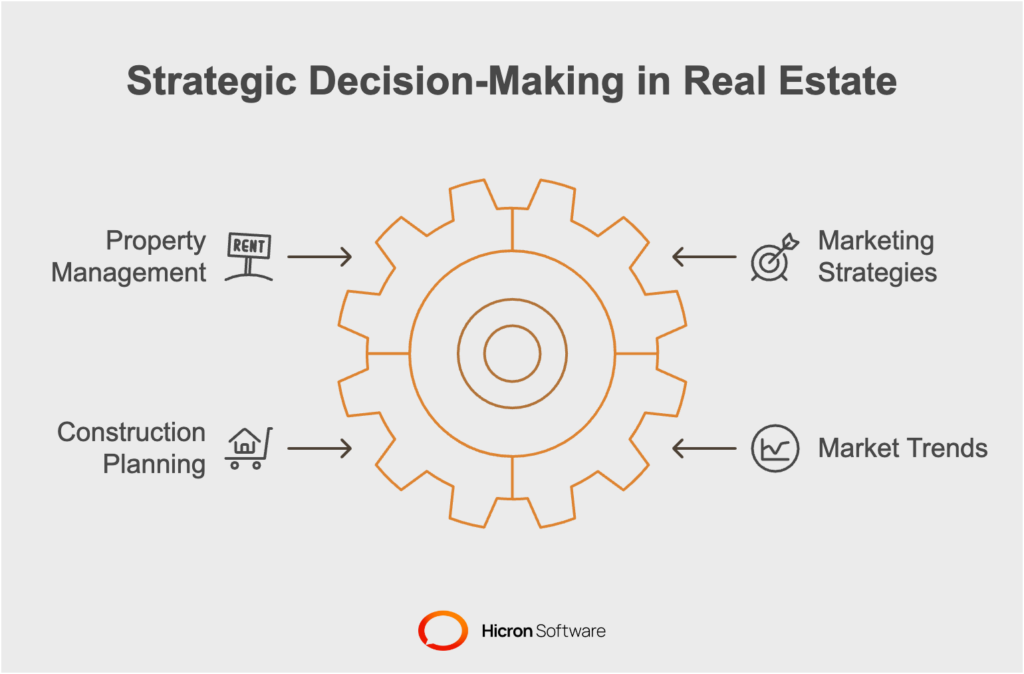
By applying historical data, commercial real estate firms react to and influence market demands, gaining a competitive advantage.
Predictive analytics is more than just a buzzword in commercial real estate—it’s a critical tool for smarter, faster, and more efficient decision-making. This advanced technology offers practical solutions for the industry’s most pressing challenges, from forecasting property trends to improving tenant retention and fine-tuning lease renewals. PropTech platforms, powered by artificial intelligence and data integration, are at the forefront of this evolution, empowering professionals to move beyond reactive management and into a proactive, forward-thinking mindset.
Using historical data, paired with advanced PropTech platforms, turns the past into a strategic advantage, offering insights that can shape a more resilient and innovative future for commercial real estate. With predictive analytics leading the way, the sector is not just adapting to change—it’s anticipating and driving it. For property managers and stakeholders alike, the message is clear: those who harness the power of predictive analytics are better positioned to thrive in a market where the only constant is change.
Efficient building operations are a critical component of commercial real estate management. From reducing energy consumption to cutting operational costs, the ability to streamline processes directly impacts the bottom line. Data-driven PropTech tools are driving these improvements, transforming how properties are managed by integrating real-time monitoring and advanced analytics.
Leveraging IoT sensors and other PropTech solutions can help property managers gain invaluable insights into building operations. These tools provide actionable data that helps teams identify inefficiencies, optimize systems, and make smarter decisions.
IoT (Internet of Things) sensors are small yet powerful tools that constantly collect data from various building parts. These sensors monitor everything from temperature and humidity to foot traffic and lighting. Combined with analytics platforms, they transform raw data into meaningful insights that allow managers to monitor building operations in real-time.
For instance, a commercial office tower with IoT sensors can track HVAC (heating, ventilation, and air conditioning) system performance. Analytics software identifies patterns in temperature fluctuations, showing where systems are overexerted or functioning inefficiently. Real-time alerts can notify maintenance teams to address potential issues immediately, reducing downtime and preventing costly repairs.
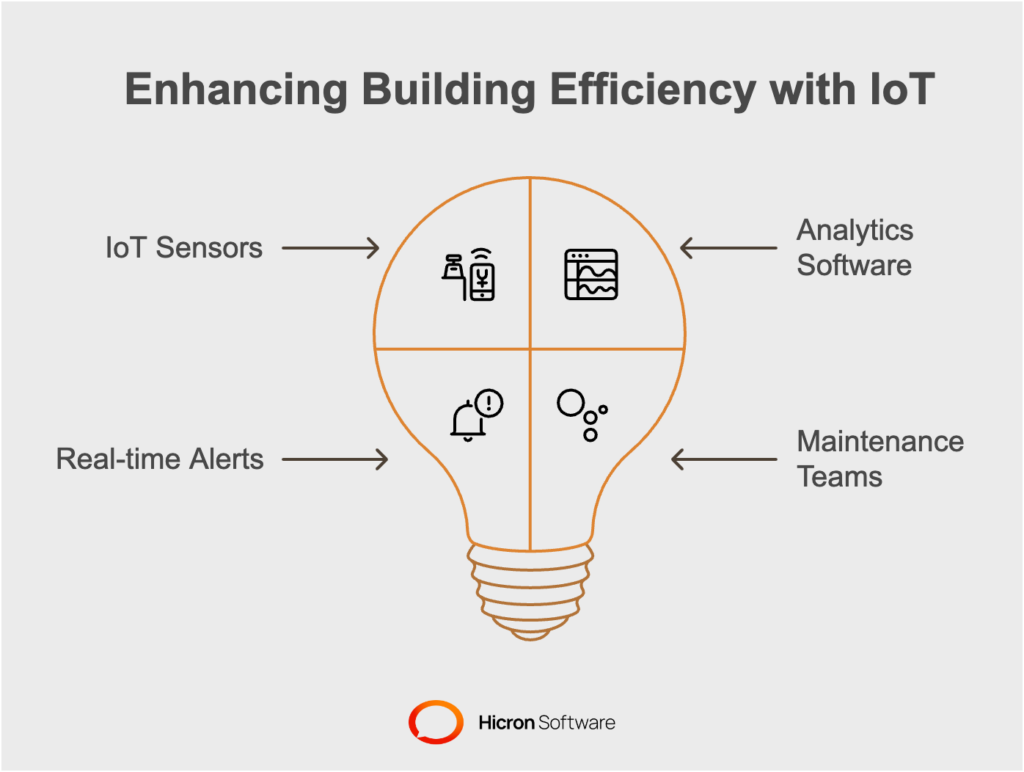
Similarly, motion-detecting sensors installed in conference rooms or common areas can gather data on space utilization. If analytics reveal underused spaces, building managers can make adjustments, such as rearranging layouts or consolidating resources, to improve functionality and reduce waste.
One of the most significant benefits of data-driven PropTech is its ability to reduce energy consumption. By using IoT devices to monitor energy use in real-time, property managers can pinpoint inefficiencies and make targeted adjustments. These small changes often lead to substantial savings over time.
Take the example of smart lighting systems. IoT sensors can detect when areas of a building are unoccupied and automatically dim or switch off lights, eliminating unnecessary energy usage. Similarly, smart thermostats adjust temperatures based on occupancy levels, ensuring heating or cooling systems aren’t wasting resources on empty rooms.
Energy analytics tools also allow properties to implement predictive maintenance schedules. Instead of waiting for equipment failures, data models can anticipate when a component is at risk of malfunctioning. Repairing or replacing something early incurs far lower costs than dealing with the aftermath of an entire system breakdown, leading to significant operational savings.
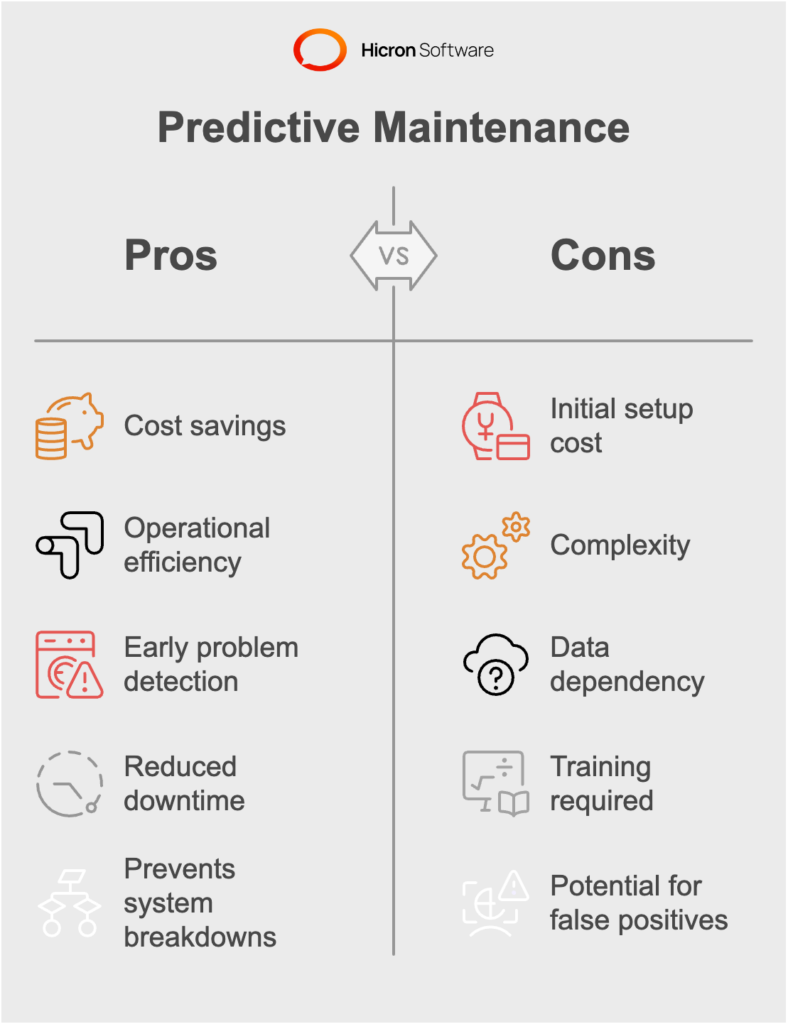
Several commercial properties have implemented PropTech tools to enhance operational efficiency and reduce costs. Here are a few examples:
#1 Office complex optimizes energy usage
A large office complex in a metropolitan city installed IoT-enabled energy meters across its buildings to track power usage in real-time. Analysis of the collected data revealed that HVAC systems were consuming excessive energy during off-peak hours. By reprogramming schedules and automating temperature controls through PropTech software, the complex reduced its energy costs by 25% within one year.
#2 Retail property enhances space utilization
A retail shopping center used occupancy sensors and foot traffic analytics to study visitor patterns. Managers discovered that certain mall areas experienced minimal foot traffic during weekdays. With this insight, they reconfigured space allocation by moving popular retail stores to underused zones, creating a more balanced traffic flow. This improved space utilization not only boosted tenant satisfaction but also increased revenue for the property.
#3 Mixed-use development adopts predictive maintenance
A mixed-use property housing residential and office spaces implemented IoT maintenance sensors throughout its HVAC and elevator systems. The data collected helped identify minor irregularities in system performance, allowing maintenance teams to fix problems before they escalated. Over two years, the property reported a 40% reduction in unplanned maintenance costs while significantly improving tenant satisfaction through minimized disruptions.
#4 Turning data into smarter operations
PropTech tools powered by IoT sensors and analytics give property managers a deeper understanding of building operations. This data-driven approach allows them to identify inefficiencies, predict issues, and optimize resource usage in ways that weren’t possible before.
Real-time insights empower teams to make informed decisions that enhance operational efficiency and tenant experiences. Whether it’s lowering energy bills, reducing repair costs, or repurposing underused spaces, the practicality of PropTech solutions is undeniable.
By adopting these technologies, commercial properties can save money and reduce their environmental impact, aligning with the growing demand for sustainable practices. The success stories highlight the tangible benefits of leveraging PropTech, proving that data-driven tools are no longer optional—they’re essential for thriving in today’s competitive real estate market.
Managing a property isn’t just about ensuring the lights stay on or the rent checks come in. It’s about creating spaces where people want to be—working, living, or shopping. And the best way to do that? Truly understanding what tenants need and value. This is where data comes in. Property managers can turn raw information into meaningful improvements using modern tools to collect and analyze tenant behavior.
From crafting personalized experiences to planning better layouts and fostering deeper tenant relationships, insight-driven decisions can make all the difference.
Tenants interact with buildings in countless ways every day. They use key cards to enter, request maintenance, frequent common areas, and use amenities. All of this activity creates data. These patterns can help property managers identify what’s working, spot inefficiencies, and understand tenant priorities.
For example, access logs might reveal gym usage spikes between 6 and 9 a.m. or tenants consistently request faster maintenance-issue responses. These aren’t just statistics—they’re opportunities to improve. By listening to the data, managers can make informed decisions that meet tenant needs.
Understanding tenant preferences goes beyond solving problems—it can guide smarter investments in the property itself. Using behavioral insights, managers can fine-tune layouts and amenities to match how people actually use the space.
#1 Rethinking how space is used
Imagine an office building where shared workspaces are consistently busy, but private offices are left empty. This might suggest creating more flexible, open areas rather than maintaining underused spots. Retail properties, on the other hand, might notice trends in foot traffic. If some parts of a mall stay quiet, relocating anchor stores or creating more appealing pathways can draw people into underutilized corridors.
#2 Investing in the right amenities
Analytics can also help managers prioritize which amenities matter most. Say data shows that a residential property’s tenants favor fitness and wellness. Instead of adding a generic lounge area, investing in a yoga studio or upgrading gym equipment would better align with tenant needs. It’s about offering what people value most rather than guessing or overinvesting in the wrong features.
These data-driven adjustments make buildings more intuitive and appealing, creating spaces where tenants feel at home or at ease.
Good property management is as much about relationships as it is about infrastructure. Data can help foster trust and connection between tenants and managers.
#1 Anticipating needs
For example, if analytics show recurring complaints about temperature issues in a particular HVAC zone, managers can intervene before the issue becomes a major frustration. When tenants see problems being solved without repeatedly asking, it tells them they’re being heard—and that’s a key ingredient for building loyalty.
#2 Personalizing communication
Beyond solving problems, insights can make communication more meaningful. Imagine sending targeted messages that align directly with tenants’ interests. For a business tenant concerned with sustainability, you might highlight new eco-friendly initiatives the building is adopting. For long-time tenants, acknowledging their loyalty with a small token of appreciation can go a long way. These small touches address tenants’ practical concerns and show them they matter as individuals.
At the end of the day, keeping tenants satisfied isn’t just good for them—it’s a win for property owners, too. Happy tenants are far more likely to renew leases, refer others, and view their property managers as partners rather than just service providers. Lower turnover rates mean fewer vacant units and reduced costs for finding new tenants.
By leveraging tenant insights, managers can proactively create a sense of belonging and satisfaction that encourages tenants to stay put. It’s not just about meeting expectations; it’s about exceeding them.
Tenant behavior data isn’t just numbers—it’s the voice of your tenants. By tuning in and acting on what they learn, property managers can transform their buildings into places where people genuinely want to be. Smarter layouts, better amenities, and thoughtful communication all contribute to the same goal: making decisions that serve the people who make a property what it is.
At the heart of it all is a simple idea—when tenants feel understood and valued, everything else falls into place. For property managers, starting with tenant insights is essential. The results? Stronger relationships, better environments, and a property that thrives year after year.
Managing properties comes with its fair share of risks, from unexpected repair costs to tenant dissatisfaction. But thanks to advancements in PropTech and data analytics, property managers now have powerful tools to spot potential problems before they escalate. This proactive approach reduces risks, saves money, and keeps properties running smoothly. Here’s a closer look at how advanced analytics and PropTech solutions revolutionize risk management and maintenance.
Risk management in property management isn’t just about responding to problems—it’s about preventing them. Advanced analytics play a key role here. These systems collect and interpret data on building systems, tenant behavior, and environmental factors. By analyzing this data, property managers can identify patterns and anticipate risks.
For example, HVAC systems can be monitored in real-time, with analytics detecting abnormal performance that suggests an impending failure. Instead of waiting for the system to break down—often at the worst possible time—managers can schedule repairs preemptively, avoiding costly emergency fixes and tenant frustration.
Not only does this approach save resources, but it also reduces operational disruptions. Tenants don’t have to deal with surprise outages, and managers aren’t scrambling to find quick, expensive solutions.
Predictive maintenance is changing the game for property maintenance, with PropTech solutions leading the charge. These tools use data from Internet of Things (IoT) sensors and machine learning algorithms to predict when equipment or infrastructure might fail.
Smart monitoring tools
IoT sensors can be installed in critical building systems such as elevators, plumbing, or electrical grids. These sensors continuously monitor usage, temperature, vibrations, and other indicators. For instance:
A sensor detecting unusual vibrations in an elevator motor might indicate wear on a component. Maintenance teams can address the issue before the motor fails, avoiding the elevator being out of service for days. Water leak detection systems installed in plumbing can detect small leaks before they turn into bursts, saving thousands in repair and water damage costs.
Machine learning applications
Machine learning takes it one step further. By analyzing historical data, these systems not only flag current issues but also predict future maintenance needs. For example, based on past data, a machine learning algorithm might predict that a building’s roof will likely need replacing within the next 12 months, allowing managers to plan and budget accordingly.
The effectiveness of data-powered tools isn’t hypothetical—it’s proven in real-world scenarios. Here are a few expanded examples of how predictive technology has helped property managers avoid costly disruptions:
Case Study no.1: Preventing an HVAC breakdown in a retail complex
Maintaining a comfortable indoor climate at a large retail property spanning acres was critical for shoppers and tenants. The building was equipped with IoT-enabled HVAC sensors that tracked metrics like airflow, temperature, and compressor vibrations. Over several weeks, data revealed subtle but consistent drops in compressor efficiency on one of the systems.
Instead of ignoring the data, property managers investigated further. Upon inspection, technicians discovered that the compressor was on the verge of failing due to wear and tear. They replaced the affected component before the unit stopped working entirely. Acting before the unit failed, property management saved nearly $15,000 in emergency repair costs. More importantly, there were no interruptions to the shopping experience, preventing tenant complaints and protecting the retail property’s reputation.
Case Study no.2: Early detection of plumbing issues in an office tower
A 20-story office building integrated smart leak detection sensors into its plumbing system. During a routine analysis of water pressure data across multiple pipelines, the system flagged a slow but consistent drop in pressure on one section. Though invisible to the naked eye, this was a strong indicator of a developing leak inside a wall cavity between two tenant offices.
The maintenance team pinpointed the issue and opened the wall to find a small but growing pipe crack caused by corrosion. They replaced the problematic section of piping within hours, spending just a few hundred dollars on labor and materials. If the issue had gone unnoticed, the pipe would have ruptured within weeks, causing flooding that could have resulted in over $50,000 in water damage and tenant displacement. By acting early, the property not only safeguarded its physical assets but also avoided damaging tenant relationships.
Case Study no.3: Ensuring structural safety in a high-rise residential building
Tenants recurringly expressed concerns about minor but noticeable vibrations in common areas in a residential tower. While the vibrations didn’t seem alarming at first, the property management company decided to install IoT sensors designed to monitor structural integrity and seismic behavior. Over time, the system detected a pattern of abnormal shifts in load distribution, specifically around a critical support beam in the building’s parking garage.
Engineers were called in to assess the problem, and they discovered that the beam had slowly been deteriorating over years of wear and environmental exposure. Repairs were scheduled immediately, and tenants were informed about the proactive measures. The cost of reinforcing the beam was a manageable $30,000. Ignoring the issue, however, could have led to severe structural damage, evacuation of hundreds of tenants, and legal liabilities totaling six figures or more. This proactive approach not only resolved the issue but also reassured tenants about their safety, fostering trust and loyalty toward management.
Proactive maintenance isn’t just about solving individual issues—it’s part of a broader strategy. Data-powered risk management helps property managers create:
By leveraging advanced analytics and PropTech solutions, property managers transform maintenance from a reactive headache into a proactive strategy for success. This data-driven approach not only protects property investments but also enhances the tenant experience—an outcome that benefits everyone involved.
For property managers navigating a complex landscape of risks, one thing is for sure: the future is proactive. With the power of data and technology, costly disruptions, tenant dissatisfaction, and operational inefficiencies are no longer inevitable challenges. Instead, they can be opportunities to innovate, improve, and thrive in a competitive market.
Technology is no longer just an add-on; it has become the driving force behind faster and more profitable property management. At the center of this shift is PropTech—innovative solutions that are revolutionizing how data is collected, analyzed, and used. Emerging technologies like machine learning and blockchain shape this transformation, redefining how decisions are made and properties are managed.
Data is everywhere in CRE, but raw information alone doesn’t cut it. The challenge for property managers and stakeholders lies in turning that data into actionable insights, which is where machine learning (ML) comes in.
Machine learning algorithms can analyze vast datasets from properties, tenants, and market trends to find patterns and predict outcomes much faster than any human could. For example:
Machine learning essentially adds a layer of intelligence to every real estate decision, improving efficiency and profitability while reducing risks associated with guesswork.
With so much data being generated and exchanged in CRE, ensuring its security and accuracy is increasingly critical. Blockchain is emerging as a game-changing technology that can create secure and transparent data ecosystems for property management.
#1 Transparent and secure transactions
Blockchain stores information in “blocks” linked together in an unchangeable chain. This makes data tamper-proof and verifiable. For CRE, this means:
#2 Enhanced trust in data sharing
One of blockchain’s most revolutionary aspects is its potential to create a shared data ecosystem. Property managers, tenants, service providers, and investors can securely access the same verified data without intermediaries. For example:
A building’s maintenance history can be stored on the blockchain, allowing service providers to track repairs and replacements accurately. Investors can access critical information about a property’s history without worrying about manipulated or outdated records.
By creating a digital “trust layer,” blockchain can eliminate inefficiencies, improve transparency, and enhance cooperation across all CRE stakeholders.
As technology evolves, so will analytics and its impact on commercial property management. It’s not a question of “if” these changes will occur, but rather “how fast” and “how far” they will progress. Here are some predictions for the future:
#1 Hyper-personalized tenant experiences
With advanced analytics becoming more accessible, property managers will gain an even deeper understanding of tenant behavior. Data will allow managers to create hyper-personalized tenant environments, from preferred amenities to optimal layouts. Imagine office spaces that automatically adjust lighting, temperature, and even desk configurations to suit the preferences of individual teams.
#2 Fully automated maintenance systems
Predictive maintenance is already here, but in the future, nearly all building systems may be completely automated. AI-powered IoT sensors could autonomously monitor, repair, and even replace parts with minimal human intervention. For instance, a building’s HVAC system might self-diagnose a failing part and schedule a robotic repair team to fix it with zero downtime.
#3 End-to-end digital transactions
The entire leasing and property-buying process may eventually move online. With blockchain as the foundation, transactions could become faster, requiring no paperwork or middlemen. Buyers and tenants can digitally sign contracts, access verified property records, and pay securely in seconds.
#4 The rise of digital twins
Digital twin technology—virtual replicas of physical properties—is poised to revolutionize real estate development and management. These twins will allow property managers to simulate changes, assess risks, and even perform virtual walkthroughs of properties. Decision-making will shift from reactive to predictive, ensuring a nearly error-free environment.
#5 A more resilient real estate market
Data analytics will enable real-time tracking of markets, better equipping property managers and investors to weather economic downturns. Machine learning algorithms will anticipate market corrections, helping stakeholders make smarter investments and avoid financial losses.
The future of CRE hinges on adopting data analytics and PropTech solutions. Machine learning and blockchain technologies begin a broader shift toward more innovative, more efficient property management. By leveraging these tools, property managers can anticipate tenant needs, streamline processes, and protect their investments in ways previously unimaginable.
Data isn’t just about numbers—it tells how buildings are used and how tenants experience them. With cutting-edge technology, property managers can become not just managers but visionaries, crafting spaces as innovative as the tenants who occupy them.
The next chapter of commercial real estate will be defined by adaptability. Those who harness the full potential of analytics and PropTech will lead the charge into a brighter and more connected future, where decisions are driven by insight and opportunities are seized with confidence.
The integration of data analytics and PropTech is reshaping commercial real estate by empowering property managers, investors, and stakeholders with tools that drive smarter and more efficient decisions. These technologies enhance nearly every aspect of property management—from improving operational efficiency with IoT sensors and predictive maintenance to fostering stronger tenant relationships through actionable insights. Data analytics allows property managers to predict future needs, optimize resources, and deliver personalized experiences that keep tenants satisfied and loyal.
The benefits go beyond day-to-day management. Predictive analytics, machine learning, and blockchain are unlocking new levels of innovation, driving cost savings, sustainability, and even market resilience. By identifying trends and risks ahead of time, commercial properties can adapt quickly and evolve to meet changing demands. This proactive approach reduces costs, minimizes disruptions, and positions properties as leaders in an increasingly competitive sector.
Informed decision-making has never been more critical for staying competitive. Real estate professionals must leverage data-driven insights to optimize operations and adapt to a dynamic market. Those who fail to do so risk being left behind. Industry players must recognize that adopting PropTech is not just about improving processes—it’s about unlocking opportunities, minimizing risks, and delivering exceptional value to tenants, investors, and stakeholders.
The future of commercial real estate is digital, data-driven, and adaptive. By using PropTech solutions, real estate professionals can lead the charge into a smarter, more sustainable, and connected landscape. Now is the time to explore and invest in these technologies, ensuring a competitive edge and long-term success in the evolving world of commercial properties. Building a data-driven strategy today creates the foundation for resilience and growth tomorrow.
